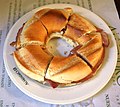Rosca
Rosca[edit | edit source]
A Rosca is a traditional pastry that is popular in various cultures around the world. It is often associated with celebrations and special occasions. The name 'Rosca' is derived from the Spanish word for 'ring', which describes the typical shape of this pastry.
Origins and History[edit | edit source]
The origins of the Rosca are believed to date back to the Roman times, when it was used in celebrations of the god Saturn during the festival of Saturnalia. Over time, the tradition was adopted by Christians and became associated with the celebration of the Epiphany.
Variations[edit | edit source]
There are several variations of the Rosca, each with its own unique characteristics and ingredients. Some of the most popular include:
- Rosca de Reyes: This is a Spanish and Mexican version of the Rosca, which is traditionally eaten on the Day of the Epiphany, January 6th. It is often decorated with candied fruit and contains a small figurine hidden inside.
- Rosca de Pascua: This is an Argentine version of the Rosca, which is typically eaten during Easter. It is usually made with a sweet dough and is often filled with pastry cream.
- Roscon de Hojaldre: This is a Spanish version of the Rosca, which is made with puff pastry and is typically filled with whipped cream or other sweet fillings.
Preparation and Ingredients[edit | edit source]
The preparation of a Rosca involves making a sweet dough, which is then shaped into a ring. The dough is often flavored with ingredients such as orange blossom water, anise, or other spices. After the dough is shaped, it is typically decorated with candied fruit or nuts before being baked.
Cultural Significance[edit | edit source]
The Rosca holds significant cultural importance in many societies. In Spain and Mexico, the Rosca de Reyes is a key part of the Epiphany celebrations, with the hidden figurine symbolizing the hiding of the infant Jesus from King Herod's troops. In Argentina, the Rosca de Pascua is a traditional Easter treat, symbolizing the resurrection of Jesus.
See Also[edit | edit source]
References[edit | edit source]
External Links[edit | edit source]
- [Example Website]
- Rosca
Search WikiMD
Ad.Tired of being Overweight? Try W8MD's physician weight loss program.
Semaglutide (Ozempic / Wegovy and Tirzepatide (Mounjaro / Zepbound) available.
Advertise on WikiMD
|
WikiMD's Wellness Encyclopedia |
| Let Food Be Thy Medicine Medicine Thy Food - Hippocrates |
Translate this page: - East Asian
中文,
日本,
한국어,
South Asian
हिन्दी,
தமிழ்,
తెలుగు,
Urdu,
ಕನ್ನಡ,
Southeast Asian
Indonesian,
Vietnamese,
Thai,
မြန်မာဘာသာ,
বাংলা
European
español,
Deutsch,
français,
Greek,
português do Brasil,
polski,
română,
русский,
Nederlands,
norsk,
svenska,
suomi,
Italian
Middle Eastern & African
عربى,
Turkish,
Persian,
Hebrew,
Afrikaans,
isiZulu,
Kiswahili,
Other
Bulgarian,
Hungarian,
Czech,
Swedish,
മലയാളം,
मराठी,
ਪੰਜਾਬੀ,
ગુજરાતી,
Portuguese,
Ukrainian
Medical Disclaimer: WikiMD is not a substitute for professional medical advice. The information on WikiMD is provided as an information resource only, may be incorrect, outdated or misleading, and is not to be used or relied on for any diagnostic or treatment purposes. Please consult your health care provider before making any healthcare decisions or for guidance about a specific medical condition. WikiMD expressly disclaims responsibility, and shall have no liability, for any damages, loss, injury, or liability whatsoever suffered as a result of your reliance on the information contained in this site. By visiting this site you agree to the foregoing terms and conditions, which may from time to time be changed or supplemented by WikiMD. If you do not agree to the foregoing terms and conditions, you should not enter or use this site. See full disclaimer.
Credits:Most images are courtesy of Wikimedia commons, and templates, categories Wikipedia, licensed under CC BY SA or similar.
Contributors: Prab R. Tumpati, MD





